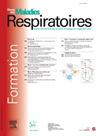Consequences of pharmacological inhibition of cathepsin S on the activation of neutrophil serine proteases
IF 0.5
4区 医学
Q4 RESPIRATORY SYSTEM
引用次数: 0
Abstract
Introduction
An uncontrolled activity of neutrophil serine proteases (NSPs; elastase, proteinase 3 and cathepsin G) contributes to chronic inflammatory pulmonary diseases. Cathepsin C (CatC), also known as dipeptidyl peptidase I (DPPI), executes the activation of NSPs and represents a promising pharmacological target in NSP-mediated diseases. Results from the Phase 3 ASPEN study using brensocatib, an active site targeting inhibitor, validate CatC as a pharmacological target in non-cystic fibrosis bronchiectasis. CatC is first synthetized as an inactive zymogen containing an intramolecular chain propeptide, the dimeric form of which is processed into the mature tetrameric form by proteolytic cleavages (Figure 1). Pharmacological inhibition of CatC can be achieved either using chemical inhibitors interacting with the mature, functional protease (direct inhibition) or by impairing the activation of its proform by targeting proCatC-converting protease(s) (indirect inhibition). In this study, we investigated the consequences of indirect pharmacological inhibition of CatC on the activation of NSPs.
Methods
CatC is maturated by CatL-like proteases (CatS, CatL, CatF, CatK and CatV) in vitro. CatL-like proteases that could maturate proCatC were investigated by proteomic approaches in neutrophilic precursor cells. Human CD34 + cells were differentiated in neutrophils with or without a nitrile CatS inhibitor, IcatS#54. CatC and NSPs were analysed in neutrophil lysates by western blotting and kinetic assays. Proteolytic pathways involved in the activation of NSPs were studied in neutrophils derived from CatC knock-out (Ctsc−/−) or CatS knock-out (Ctss−/−) mice.
Results
We show that CatS, a potent elastinolytic enzyme, is the major druggable converting protease involved in the maturation of human neutrophil proCatC. Pharmacological targeting of intracellular CatS using IcatS#54 almost completely blocked CatC maturation in CD34 +-derived neutrophils and resulted in inactivation and elimination of NSPs (∼70 %). However, CatS is not the major protease responsible for CatC maturation in rodent. Characterisation of proteolytic cascades involved in the activation of macaque NSPs is under investigation.
Conclusion
We established a proof of concept for the indirect inhibition of NSPs by pharmacological targeting of CatC maturation using CatS inhibitors. This emphasizes the potential of CatS as a therapeutic target for inflammatory diseases. Thus, preventing proNSP activation using a CatS inhibitor, alone or in combination with a CatC, represents a promising approach to efficiently control the extent of tissue injury in neutrophil-mediated inflammatory diseases.
求助全文
约1分钟内获得全文
求助全文
来源期刊

Revue des maladies respiratoires
医学-呼吸系统
CiteScore
1.10
自引率
16.70%
发文量
168
审稿时长
4-8 weeks
期刊介绍:
La Revue des Maladies Respiratoires est l''organe officiel d''expression scientifique de la Société de Pneumologie de Langue Française (SPLF). Il s''agit d''un média professionnel francophone, à vocation internationale et accessible ici.
La Revue des Maladies Respiratoires est un outil de formation professionnelle post-universitaire pour l''ensemble de la communauté pneumologique francophone. Elle publie sur son site différentes variétés d''articles scientifiques concernant la Pneumologie :
- Editoriaux,
- Articles originaux,
- Revues générales,
- Articles de synthèses,
- Recommandations d''experts et textes de consensus,
- Séries thématiques,
- Cas cliniques,
- Articles « images et diagnostics »,
- Fiches techniques,
- Lettres à la rédaction.
 求助内容:
求助内容: 应助结果提醒方式:
应助结果提醒方式:


